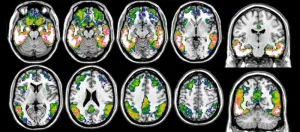Tau-PET : a window into the future of Alzheimer’s patients
A UNIGE-HUG team demonstrates the value of imaging to detect the presence of tau protein in the brain to predict cognitive decline due to Alzheimer’s disease
2023-08-09
(Press-News.org)
Alzheimer’s disease, one of the most common neurodegenerative diseases, leads to progressive loss of memory and autonomy. It is characterised by the accumulation of neurotoxic proteins in the brain, namely amyloid plaques and tau tangles. Due to the silent development of pathology over decades, very early diagnosis is of utmost importance to be able to take action as early as possible in the disease process. A team from the University of Geneva (UNIGE) and the Geneva University Hospitals (HUG) has demonstrated that tau PET - a novel imaging technique for visualising the tau protein - can predict cognitive decline in patients much better than the imaging techniques normally used. These results, published in Alzheimer’s & Dementia: The Journal of the Alzheimer’s Association, argue in favour of the rapid introduction of tau PET into the clinical routine to provide patients with early and individualised solutions.
Today, one of the main diagnostic tools for Alzheimer’s disease is positron emission tomography (PET), an imaging technique in which tracers are injected to visualise specific pathological processes in the brain. "PET involves injecting patients with low-level radioactive tracers that disappear within a few hours. They are designed to bind to the human molecules that we want to detect, making them visible with the PET tomographs," explains Valentina Garibotto, Associate Professor in the Department of Radiology and Medical Informatics at UNIGE Faculty of Medicine and Head Physician in the Division of Nuclear Medicine and Molecular Imaging at the HUG, who directed this research.
"Specific tracers for amyloid exist since two decades, and tracers to monitor glucose metabolism, which indicates the brain’s ability to use its energy resources correctly, have long existed. However, Alzheimer’s disease is complex and these two techniques are not enough to provide all the answers."
Comparing imaging techniques
Flortaucipir is a radiotracer that binds to the tau protein. It was developed by a pharmaceutical company and approved by the Food and Drug Administration (FDA) in 2020. It allows the detection of tau accumulation as well as its distribution in the brain to precisely assess its role in the clinical manifestation of the disease. Scientists from the UNIGE and the HUG wanted to determine which imaging modality - amyloid PET, glucose metabolism PET, or tau PET - would best predict future cognitive decline due to Alzheimer’s disease. Around 90 participants were recruited at the HUG Memory Centre.
"Our results show that while the various PET measures were all associated with the presence of cognitive symptoms, confirming their role as strong indicators of Alzheimer’s disease, tau PET was the best to predict the rate of cognitive decline, even in individuals with minimal symptoms," summarises Cecilia Boccalini, a PhD student in Professor Garibotto’s team and first author of this study.
Detecting individual variations
Amyloid plaques are not necessarily accompanied by cognitive or memory loss. However, the presence of tau goes hand in hand with clinical symptoms. Its absence or presence is the main determinant of whether a patient’s condition remains stable or deteriorates rapidly. It has been more difficult to develop imaging techniques to visualise tau, mainly because of its lower concentration and particularly complex structure.
"This breakthrough is crucial for better management of Alzheimer’s disease. Recently, drugs targeting amyloid have shown positive results. New drugs targeting the tau protein also look promising. By detecting the pathology as early as possible, before the brain is further damaged, and thanks to new treatments, we hope to be able to make a greater impact on patients’ future and quality of life," Valentina Garibotto points out. "Similarly, we are beginning to map the distribution of tau in order to understand how its location in the different regions of the brain influences symptoms." Indeed, the causes and different stages of the disease are proving to be much less uniform than previously thought, and individual susceptibility to the same phenomena needs to be better understood.
These results are a strong argument in favour of incorporating tau PET into the routine clinical evaluation to assess individual prognosis and select the most appropriate therapeutic strategy for each patient.
END
ELSE PRESS RELEASES FROM THIS DATE:
2023-08-09
A new DNA study has nuanced the picture of how different groups intermingled during the European Stone Age, but also how certain groups of people were actually isolated. The study was carried out by researchers at Uppsala University working with an international team of researchers, who produced new genetic data from 56 Central and Eastern European individuals from the Stone Age. The results have been published in the journal Communications Biology.
“Conducting studies like this one requires a broad interdisciplinary discussion. In this study, this discussion has been exceptionally fruitful,” says Tiina Mattila, population geneticist at Uppsala ...
2023-08-09
Odorants are widely used in natural gas for leak detection, however, few studies have examined their potential effects on public health. A new peer-reviewed publication in Current Environmental Health Reports, suggests that some commonly-used natural gas odorants may induce a range of adverse health symptoms at very low concentrations, ranging from headaches to respiratory inflammation and skin rashes.
“Our sense of smell is the first line of defense in detecting gas leaks, but few studies have examined how odorants in gas may adversely affect our health or well-being,” said the review’s lead author, PSE Healthy Energy Senior Scientist Drew Michanowicz. “The ...
2023-08-09
Research Highlights:
Between 1990 and 2019, the total annual number of premature CVD deaths and years of disability attributable to particulate matter air pollution rose by 31% worldwide.
The increase in deaths was unevenly distributed by sex, with a 43% increase in deaths among men compared to a 28.2% increase among women.
During the nearly 30 years of data reviewed, deaths and disability attributed to outdoor particulate matter pollution rose, while deaths associated with indoor use of solid fuels declined.
Regions ...
2023-08-09
Dam constructions have flooded over 1.13 million acres of tribal land in the US contributing to the historic and ongoing struggle against land dispossession for Indigenous peoples in the United States. New research, published in Environmental Research Letters, has identified that a region of tribal land larger than the state of Rhode Island has been submerged by dams in the US. The findings raise concerns about the destruction of ecosystems, cultural heritage, and livelihoods.
The new study shows that dams have significantly contributed to land loss of Native people, a factor that ...
2023-08-09
An analysis published in Cancer Medicine reveals the trends of self-initiated deaths—including assisted suicide (AS) and conventional suicide (CS)—in Switzerland over a 20-year period, focusing on people who suffered from cancer. Although supporters of assisted dying state that access to AS should lead to a reduction in violent CS, the study’s findings do not confirm this assumption. The situations and motivations for cancer-associated CS seem to be clearly different from those for cancer-related AS.
In Switzerland, assisting in a suicide is not punishable as long as it does not serve selfish motives. ...
2023-08-09
New research published in The FASEB Journal indicates that increasing the expression of a particular gene may help to prevent bone loss associated with postmenopausal osteoporosis.
For the study, investigators examined which genes are involved in turning precursor cells called bone marrow–derived mesenchymal stem cells (BMSCs) into cells that play a crucial role in bone formation. The screen identified a gene that encodes high mobility group AT-hook 1 (Hmga1), a protein that controls the expression of a variety of other genes.
In experiments conducted in rats, expression of Hmga1 increased during bone formation but decreased when rats’ ovaries were removed ...
2023-08-09
In research published in Arthritis & Rheumatology, investigators developed and validated a tool called PRESTO that identifies patients with psoriasis who face an elevated risk for developing psoriatic arthritis and may therefore benefit from preventive therapies.
Among 635 patients with psoriasis followed in the University of Toronto psoriasis cohort, 51 and 71 developed psoriatic arthritis during 1-year and 5-year follow-up periods, respectively. The risk of developing psoriatic arthritis within 1 year was higher in patients with younger age; male sex; family history of psoriasis; back stiffness; nail pitting (dents, ...
2023-08-09
Through next-generation sequencing, investigators have identified a mutation in the TMCO3 gene in two sisters with short stature.
The research, which is published in the Journal of Bone and Mineral Research, also revealed that the TMCO3 protein is expressed by chondrocytes, cells responsible for bone growth, and that it regulates expression of two other proteins known to control bone growth (parathyroid hormone-related protein and Indian hedgehog). TMCO3 appears to transport protons in exchange for potassium across a protein packaging organelle within cells.
The scientists confirmed that the mutation in TMCO3 was responsible for the sisters’ ...
2023-08-09
An analysis of the hierarchy of tipping points suggests that during the last 66 million years two events set the scene for further climate tipping and for the evolution of the climate system in particular. If the anthropogenic climate change of today leads to complete deglaciation, the evolution of Earth's climate will be influenced on a geological time scale, the authors suggest. The work by Denis-Didier Rousseau, Université Montpellier, France, Witold Bagniewski, Ecole Normale Supérieure, Paris, France, and Valerio Lucarini, University of Reading, UK is published in Scientific Reports and is part of the European TiPES project on tipping points ...
2023-08-09
PHILADELPHIA – The transfer of a neurotransmitter from one type of skin cell to another (melanocytes to keratinocytes) altered electrical activity and promoted melanoma initiation in preclinical models, according to results published in Cancer Discovery, a journal of the American Association for Cancer Research.
Melanoma is a deadly form of skin cancer that develops in melanin-containing skin cells known as melanocytes. An intrinsic feature of melanocytes is their ability to secrete melanin-containing vesicles to surrounding skin ...
LAST 30 PRESS RELEASES:
[Press-News.org] Tau-PET : a window into the future of Alzheimer’s patients
A UNIGE-HUG team demonstrates the value of imaging to detect the presence of tau protein in the brain to predict cognitive decline due to Alzheimer’s disease





